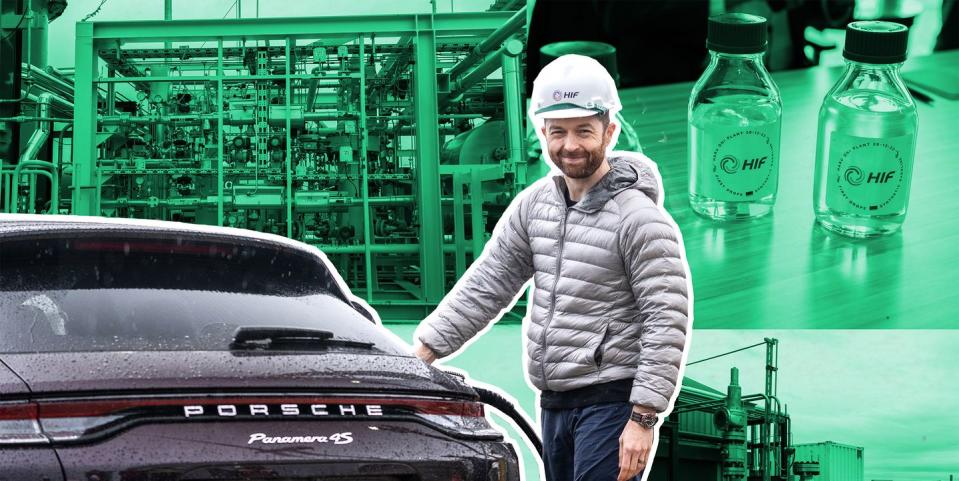Porsche's $100 Million Crusade to Future-Proof Internal Combustion


Porsche is a brand with trouble ahead, but it's a little hard to spot. It's not in the financials: Since its IPO last September, the company's share price has jumped by more than 40 percent. Likewise, while many manufacturers struggled through the pandemic and subsequent global supply chain woes, Porsche's sales barely dropped, then surged, going from 272,162 in 2020 to 309,884 in 2022.
Porsche even seems well-positioned to deal with the impending wave of emissions-free legislation, finding early success with the Taycan, launching an all-electric Macan soon, and pledging an 80 percent-electrified by fleet 2030.
It's only when you combine that legislation with Porsche's provenance that you begin to see the problem. 70 percent of all Porsches ever built are still on the road today. That's more than 700,000 911s alone. It's an enviable legacy that may soon become a bit of a burden. The upcoming ban on internal combustion sales, coming as soon as 2035 in places like California, threatens to send all those Carreras into museum collections.

Yes, the 2035 ban on internal combustion only applies to new cars, but it'll have immediate and drastic effects on demand. Start fiddling with the demand and the oil industry's supply is going to get complicated. Porsche, then, is looking at ways to create a new supply, placing a $100 million bet on an seemingly unlikely source: synthetic, emissions-neutral fuel. Chilean emissions-neutral fuel, which is exactly where we went to sample it.
Porsche Program
Porsche has so far invested $100 million into the development of synthetic fuels, more commonly called e-fuels, a form of gasoline that literally comes out of thin air. Of that $100 million, three-quarters went to HIF Global, a synthetic fuels research company that turned around and built a prototype factory called Haru Oni near Punta Arenas, Chile. It's just down the road from Torres del Paine National Park, one of the most stunning places on earth, an untouched paradise and bucket list entry for serious hikers around the globe. Why plunk a factory down here? Because this is among the windiest places on earth, and wind is the key ingredient.

HIF estimates 6,000 hours per year of "good quality wind" -- that is, blowing at a constant rate in a constant direction. It's a remarkable sum considering there are 8,760 hours in a calendar year.
The Process
E-fuels start with hydrogen generated from electrolysis. This entails, basically, zapping water with electricity, splitting the bonds holding those H2O molecules together to emit pure hydrogen and pure oxygen. The hydrogen is captured and compressed, exactly the stuff you would use to power a fuel cell car like a Toyota Mirai.

It'll take some carbon in the mix to be something you can pump into your current daily driver. Right now, that carbon comes from a giant tank of carbon-dioxide, but Haru Oni will eventually pull CO2 from the air. That carbon is combined with the hydrogen to create the e-fuel in a process called synthesis.
The result is gasoline so authentic your engine can't tell the difference.
The Result
The final stuff coming out of the end of the long, tangled series of pipes at Haru Oni is a synthetic fuel that is 100% chemically identical to gasoline. 93 octane, to be specific, though higher or lower tests are possible if needed.
It's shelf-stable, storing easily in the same sort of can that you would use for normal gasoline. Pumps, hoses, and gaskets won't be affected, nor should any timing or compression changes be required unless your precious gem sups on race gas. Porsche's e-fuel even smells like the real thing, having the same sweet, acerbic effect on your sinuses as high-test of the fossil variety.

And, yes, e-fuel gives off carbon dioxide when it combusts, just like the real thing. So how is this any better than gasoline? Once Haru Oni's carbon capture system is online, all that carbon will come out of the air, so conceptually this is just a round trip, an exciting journey for those carbon atoms plucked from the air just a stone's throw from Antarctica and then released again out of the tailpipe of some classic Porsche idling its way onto the lawn at Pebble Beach.
Given the renewable nature of all the energy that went into the process, theoretically this whole dance is environmentally neutral, a product that can be pumped directly into any existing car and run with neither modification nor bad karma. But is it for real?

 Yahoo Autos
Yahoo Autos 